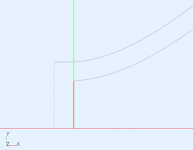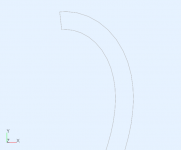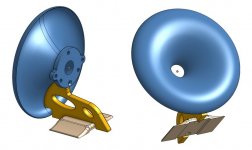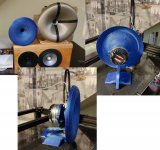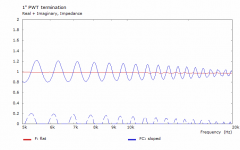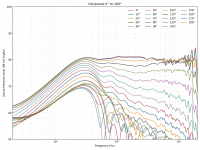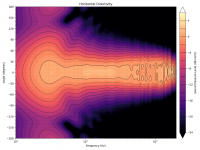Ok, I got your point. But the profile looks like it terminates in a virtual wall and with respect to this it should be already as smooth as possible. I am not sure how such ripples or narrowings are related to the underlying model. I assume that this was a free-standing calculation with interface and subdomains for back-side etc. Could you post an ABEC project of this underterminated horn?
It's a free standing horn simulated in free field. For the "underterminated" case I simply cut off the rollback (where there was the absorber before). No interfaces used, i.e. all in one exterior subdomain.
- Even a waveguide terminated into an infinite baffle can be underterminated.
- Even a waveguide terminated into an infinite baffle can be underterminated.
This is really the whole solving script.
Code:
Control_Solver
f1=300; f2=20000; NumFrequencies=100
Abscissa=log; Dim=CircSym; MeshFrequency=36000
Nodes "Nodes"
Scale=1mm
1 0.000 0.000
2 0.000 12.700
3 0.373 12.721
4 0.808 12.751
// ...
SubDomain_Properties
SubDomain=1; ElType=Exterior
Elements "Source"
RefNodes="Nodes"
Subdomain=1
1 1 2
Elements "Horn"
RefNodes="Nodes"
Subdomain=1
2 2 3
3 3 4
4 4 5
// ...
Driving "Drive"
DrvGroup=1001
RefElements="Source"
1 1 Weight=1
Last edited:
By unintuitive I meant what you said, that "a perfect absorber would also be a near perfect reflector". I still don't quite understand what's happening in the simulations above. I used perfectly absorbing BEM elements before and there really wasn't any reflection I think, for example when it was used as a "cover" of a waveguide. Now it seems to behave differently but it's still not clear to me why. All I can see is that the contour is not well terminated, somehow.
Infinite absorption works well as a boundary, but not internal to the model. At a boundary the energy goes off to infinity - no problem, but when we have nodes like this internal to the sim, then where does the energy go? Into a black hole? It's just not realistic, hence the results can be horribly wrong and misleading. You simply can't do this and get realistic results.
Hmm, I imagined the absorptive BEM elements as something that simply dissipates any sound entering that boundary and it doesn't matter how exactly it does it, i.e. what is behind that boundary - as if that was hidden from the model. The energy simply disappears from the system into that boundary and won't reflect back. I would have about the same idea about a block of foam that converts the entering sound into heat.
Last edited:
Just thinking out loud - maybe it's possible that in real life, such an element cannot exist due to impedance mismatch?Hmm, I imagined the absorptive BEM elements as something that simply dissipates any sound entering that boundary and it doesn't matter how exactly it does it, i.e. what is behind that boundary - as if that was hidden from the model. The energy simply disappears from the system into that boundary and won't reflect back. I would have about the same idea about a block of foam that converts the entering sound into heat.
Then again, it would be much the same with the latest metamaterial absorbers, so... KEF Planning Speakers With Metamaterial Absorption Technology | StereoNET United Kingdom
From the documentation:
It may seem unintuitive. But I think it's the same reason why a PWT must be dampened very gradually even with a good absorber for a reflection not to happen, right?
-Oh, wait a minute. I think I could simulate an infinite tube by placing a perfect absorber at the end of it?! 😕
Mabat, note, that 100% absorption will appear only for sound waves that are normal to the absorbing boundary surface(or propagating only in one direction). To absorb waves falling at any angle you should set so called "perfectly matched layer"(PML) instead of simply match acoustic impedance of the boundary. But ABEC3 doesn't have the PML option.
Here is a good introduction to the problem
https://math.mit.edu/~stevenj/18.369/pml.pdf
What I see is that you are creating a region - within your model - which is exterior to the problem. That is an unreal condition for any known material - i.e. complete isolation within a given interior space. It's simply impossible. What appears like reflections could just be a problem with the math trying to normalize/settle to this unrealistic condition. The math is telling you what would happen IF you could actually do this impossible thing.
OK, now I see the problem, I didn't think about this before. Pretty difficult stuff, isn't it.
This is a 1" PWT terminated with a 100% absorbing wall (the green element) at different angles:


This is a 1" PWT terminated with a 100% absorbing wall (the green element) at different angles:
Attachments
Last edited:
We're waiting, eager to see the measurements 🙂"Rapid" prototyping in DIY praxis..... Ready to measure the small one with DE360.
Thanks to Mabat once more.
Normally, I wouldn't be much interested in such a small waveguide but these free standing ones are really interesting.
...a little bit less CD with a smoother overall DI curve...
Does anyone know of any research investigating DI slope and listener preference? It's well established that the DI should be smooth, but I've not seen anything comparing, for example, smoothly increasing DI vs flat DI.
I don't but I think I could provide waveguide samples for such kind of study. That reminds me that I still need to implement the DI calculation into the sims.
It'd definitely be interesting to see such a study done. Unfortunately I don't have the expertise (or the means) to do it properly. As you may remember, the speakers I built earlier this year were optimized more for flat DI (measurements attached... ignore below ~1kHz) at the expense of some axial ripple, but I can't help but wonder if my priorities should have been slightly different... 

Attachments
Are you not satisfied with the sound? When I first saw your speakers I thought that the weakest point would be the woofer. But yeah, I would probably prefer a little bit of overall smoothness over the ruler flat DI (which will fall below ~1 kHz anyway).
Last edited:
I really like how this behaves (in a very good match with the sims, BTW).
How does it sound only Pet007 knows but he hasn't complained so far.
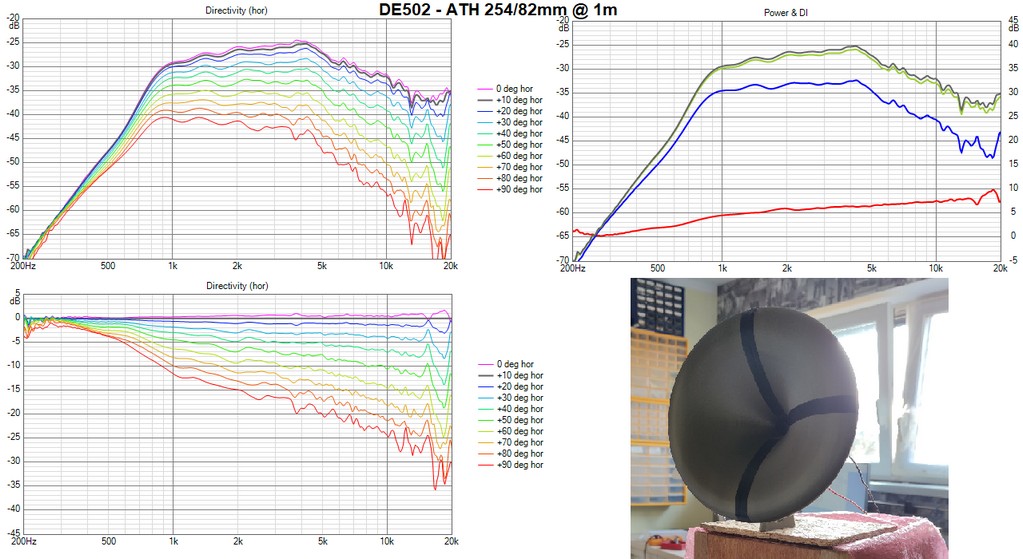
How does it sound only Pet007 knows but he hasn't complained so far.
I'm perfectly satisfied with them, I just tend to obsess over small details. Just because they're the best I've heard doesn't mean they couldn't be a little better, right? 🙄
Why do you think the woofer is the weak point? I haven't seen any problems in my testing.
Why do you think the woofer is the weak point? I haven't seen any problems in my testing.
- Home
- Loudspeakers
- Multi-Way
- Acoustic Horn Design – The Easy Way (Ath4)
